Brian Brenner, P.E., F.ASCE, is a professor of the practice at Tufts University and a principal engineer with Tighe & Bond in Westwood, Massachusetts. His collections of essays, Don’t Throw This Away!, Bridginess, and Too Much Information, were published by ASCE Press and are available in the ASCE Library.
In his Civil Engineering Source series More Water Under the Bridge, Brenner shares some thoughts each month about life as a civil engineer, considering bridge engineering from a unique, often comical point of view.
A small city named “Louisiana” is in northeast Missouri, on the banks of the Mississippi next to Illinois. I was curious how Louisiana, Missouri, was named. Town Administrator Bryan Spencer shared some information:
“Louisiana is one of Missouri's older towns and is believed to have been named for Louisiana Bayse, reportedly the first child born in St. Louis after the Louisiana Purchase. Her father, J. W. Bayse, moved his family to the new town in 1818 when his daughter was 14 years old."
So, the city predates establishing both the states of Louisiana and Missouri and that helps to explain how the city ended up with its interesting name.
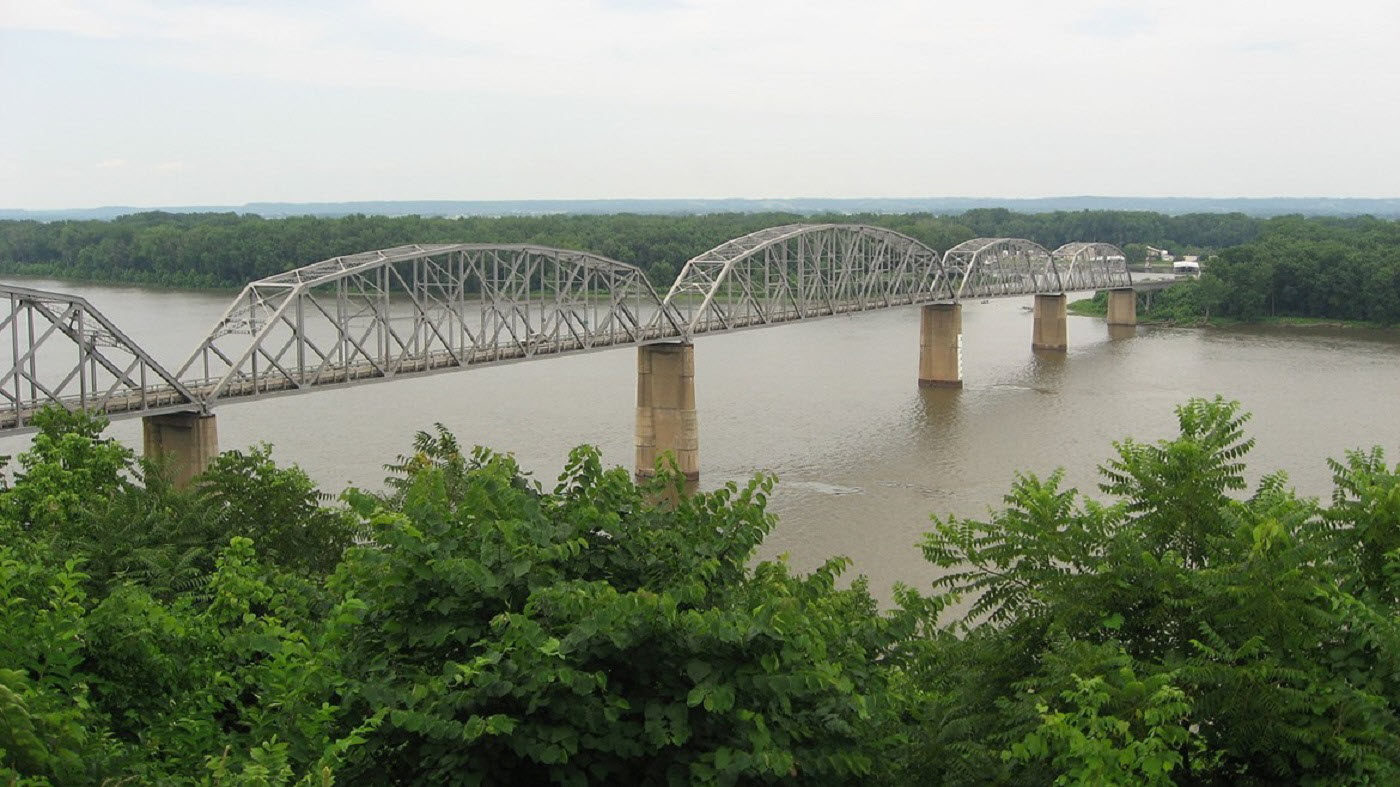
To cross the Mississippi to get to Illinois from Louisiana, Missouri, you would drive across the Champ Clark Bridge. The original Champ Clark Bridge opened to traffic in 1928 as a toll bridge and was later incorporated in the state highway system in 1953. The bridge featured five steel Pennsylvania through-truss spans over the river and seven steel I-beam approach spans. The 418-foot-long main span crossed the river’s navigation channel. The original deck was 20 feet wide and had two narrow 10-foot lanes with no shoulders. Vertical clearance from deck to truss chords was only 14.7 feet.
The old bridge featured a classic form common for its era. The structure helped to visually define this stretch of the river. In addition to the highway bridge, a railroad truss bridge crosses about half a mile downstream. The railroad bridge is not as high above the river and includes a draw swing span that remains open to permit passage of river traffic.
The main spans of the highway bridge were constructed of traditional truss shapes, similar to most of the early Mississippi crossings. Bridges further south have longer spans that were mostly cantilever trusses. These have been gradually replaced by cable-stayed bridges. A few of the older bridges that were not trusses are the deck arch spans of the Eads Bridge in St. Louis, still in service, and the twin suspension bridges at the Quad Cities crossing, which have recently been replaced by a large overdeck arch bridge.
The original Champ Clark Bridge was functionally obsolete, with a traveled way only 20 feet wide. This was not just an academic consideration. The deck was so narrow that it was difficult for two trucks to pass side by side. During construction, builders of a replacement bridge were frequently on the lookout to avoid falling sideview mirrors knocked off trucks by the truss members.
Missouri DOT rehabilitated and reconstructed parts of the old bridge over the years. But approaching a century of service, the bridge was structurally deficient, in addition to its substandard geometry. It was time for replacement.
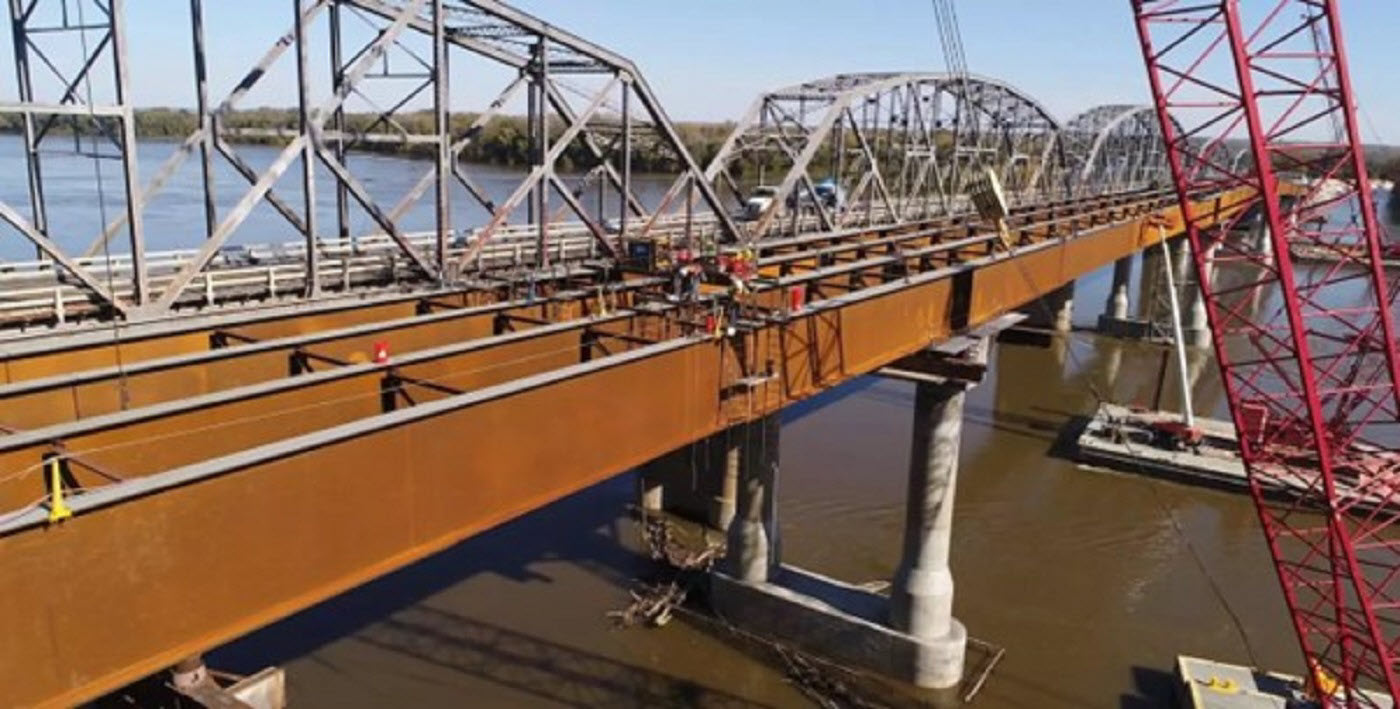
MoDOT signed a design-build contract with the Massman Construction Company in June 2017. Major construction started later that year. The new bridge was built to the south of the old one with traffic service maintained. The new Champ Clark Bridge opened on Aug. 3, 2019.
The old bridge was demolished in October 2019. Part of the demolition is recorded here.
The new Champ Clark Bridge features a continuous steel girder composite concrete superstructure. The main span is 420 feet long, with an adjacent secondary span also of that length. The plate girders vary in depth from 10’2” to 12’7” and are built out of weathering steel. The girders are designed to be continuous over five spans at a length of 1,845 feet. The steel girders are composite with a precast concrete deck. A second continuous unit of three prestressed concrete girders connects to the main steel spans on the Illinois approach.
The new bridge appears as a slender linear ribbon crossing the wide river. The color of the weathering steel contrasts with the white concrete barriers and pier bents. It is a classic form-follows-function structure, well-proportioned and aesthetically excellent in its simplicity. There is no structure above-deck to block the view. While driving across, the view is of the wide Mississippi River and its banks with no obstructions. This is a much different experience than the previous drive through narrow over-deck trusses.
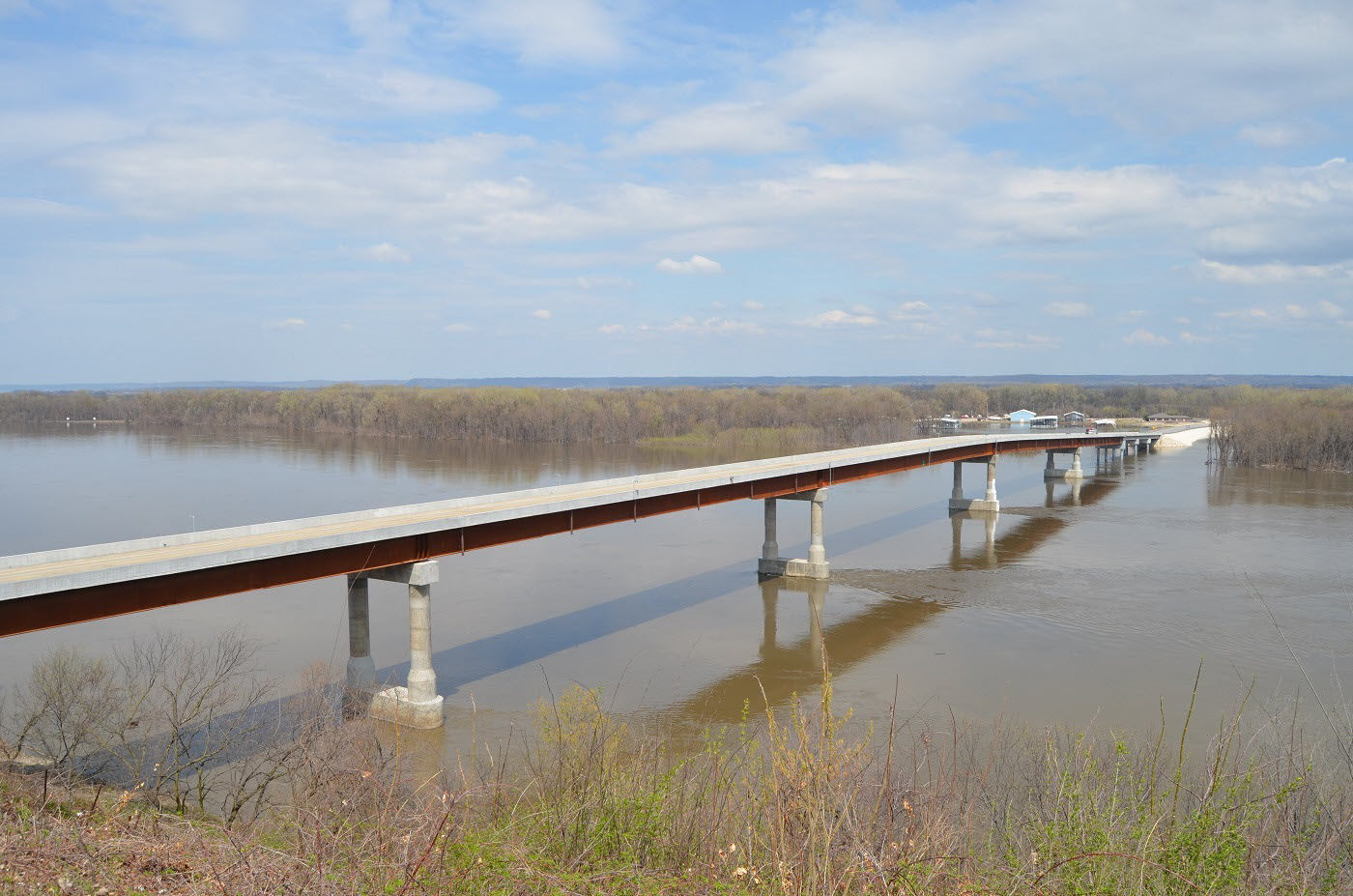 Keith Killen
Keith Killen The old Champ Clark Bridge is gone, but it lives on in Google Street View. Google updated views of the main artery, U.S. Route 54, as recently as July 2023. In these views, when you “Google drive,” you cross the new bridge on a wide, modern roadway. Sweeping views of the river are not blocked by any over-deck truss members.
However, side streets adjacent to Route 54 have not been updated as recently. Most current street views there show the old truss bridge still crossing the river. It is a ghost bridge, present in Google’s imagination but no longer corporeally on earth.
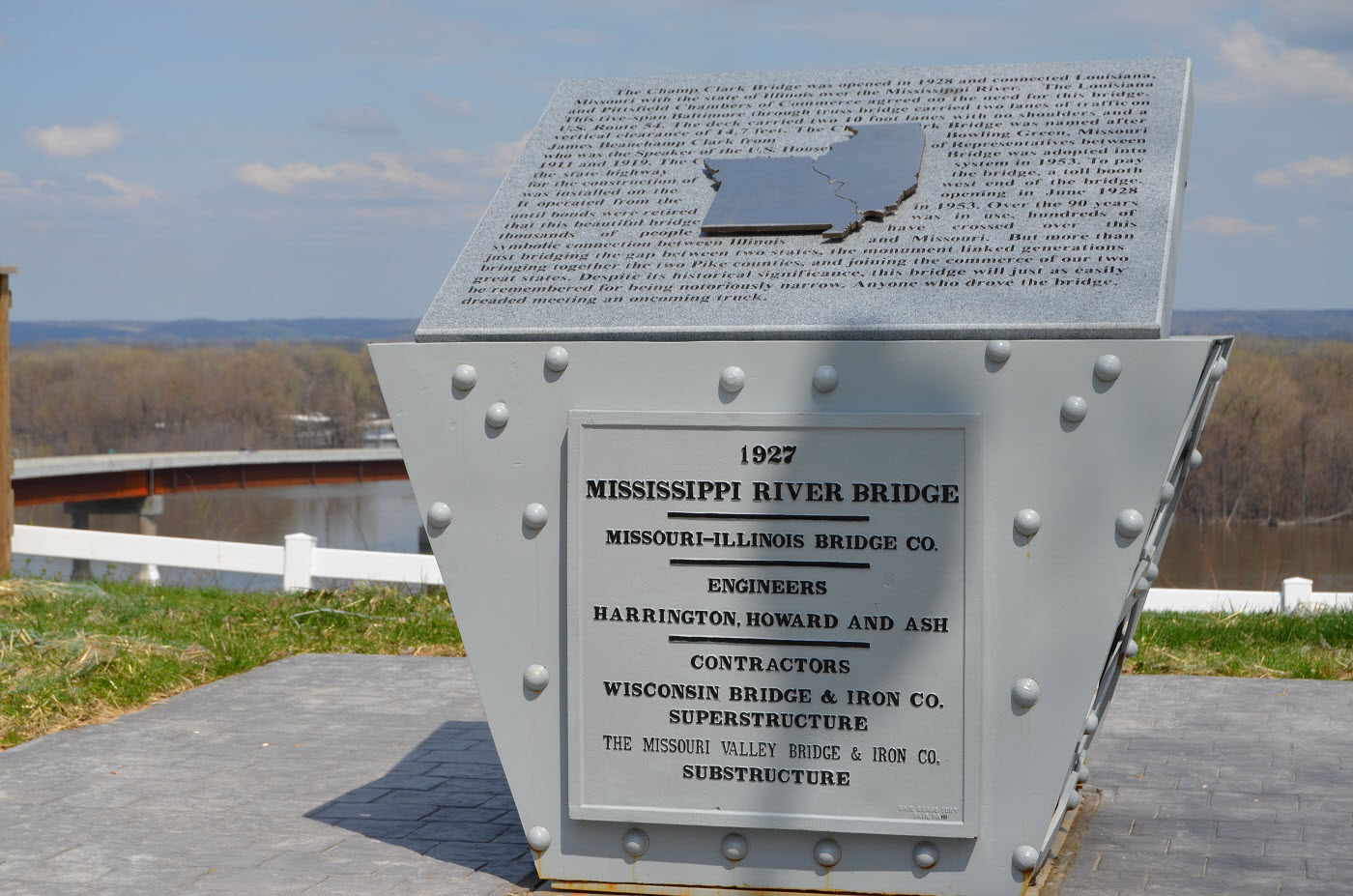 Keith Killen
Keith Killen The gradual updating of Google views leads to this interesting effect. Infrastructure views tend to be pretty static, but not completely so. As some major structures like the new Champ Clark Bridge are built, the photo database is gradually updated. But vestiges of old structures live on in nooks and crannies at least for a while. If you are looking for the traditional river view across the Mississippi toward Illinois, you can Google drive to Noyes Street at Riverside Park. There you will find a group of photos from 2012 showing the old bridge lazily crossing the river in all its past glory.
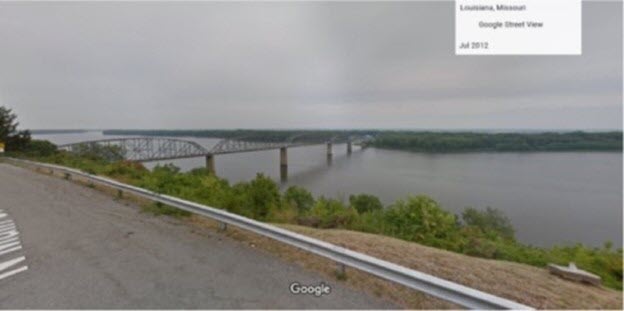
For those who know this place, the nostalgic view is there to evoke memories. But then, if you Google drive down the block to the main highway, the old truss bridge vanishes like a desert mirage, and the new modern structure takes its place.
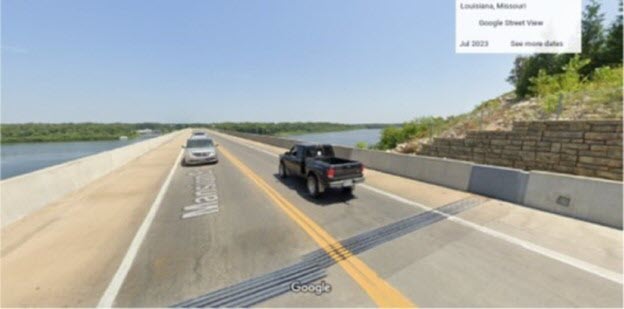
Acknowledgements
Thanks to HNTB design manager Hans Hutton and Missouri DOT Project Manager Keith Killen for sharing their insights and providing information about the new bridge. Mr. Killen provided some photos from the site. Thanks also to Louisiana Town Administrator Bryan Spencer, who described some of the town’s history.
References
“Replacing the Champ.” https://www.hntb.com/designer/replacing-the-champ/
Accessed Oct. 31, 2023.
“Champ Clark Bridge” (1928). https://en.wikipedia.org/wiki/Champ_Clark_Bridge_(1928)
Accessed Oct. 31, 2023.
“Champ Clark Bridge” (2019). https://en.wikipedia.org/wiki/Champ_Clark_Bridge_(2019)
Accessed Oct. 31, 2023.
“NO. 5 BRIDGE: Champ Clark Bridge over the Mississippi River (U.S. Hwy 54),” by Brian W. Budzynski. Roads and Bridges, Nov. 5, 2019.
Accessed Oct. 31, 2023.



